Evolving Planet at the Field Museum (Part III)
This is the third part of my coverage of the "Evolving Planet" exhibit at the Field Museum in Chicago. You may find other posts about this fantastic museum on this blog. I have written about the general exhibits, the Underground Adventure, and the King Tut exhibit. You may find part one of this exhibit here.
At this point in the exhibit, 50% of life on Earth has been wiped away, including all the dinosaurs that were not birds.
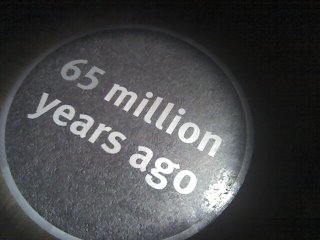 With them out of the way, 65 million years ago, it was the end of the Cretaceous period and the start of the age of the mammals. Us. The good guys (we think). Our world as we know it began to take shape. The Tertiary period (65-1.8 million years ago) was in full swing.
With them out of the way, 65 million years ago, it was the end of the Cretaceous period and the start of the age of the mammals. Us. The good guys (we think). Our world as we know it began to take shape. The Tertiary period (65-1.8 million years ago) was in full swing.
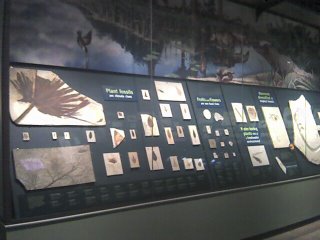 Plant and animal life (specifically mammals) that is familiar to us started to flourish.
Plant and animal life (specifically mammals) that is familiar to us started to flourish.
 Fossils of some familiarity began to be found.
Fossils of some familiarity began to be found.
This Sycamore leaf is dated 54.8-33.7 million years ago and was found in Wyoming.
 This fantastic fossil is a pregnant stingray with its embryo and herrings, dated 54.8-33.7 million years ago. This was also found in Wyoming.
This fantastic fossil is a pregnant stingray with its embryo and herrings, dated 54.8-33.7 million years ago. This was also found in Wyoming.
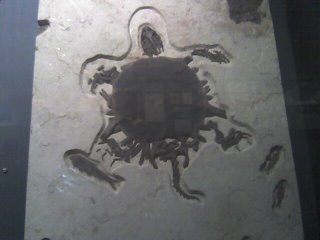 This soft-shelled turtle with fishes and love bugs inside is also dated 54.8-33.7 million years ago and found in Wyoming. It is a wonderful fossil because it not only shows the larger animal, but smaller ones as well.
This soft-shelled turtle with fishes and love bugs inside is also dated 54.8-33.7 million years ago and found in Wyoming. It is a wonderful fossil because it not only shows the larger animal, but smaller ones as well.
 This Herring-like fish (Diplomystus dentatus) is dated 54-8-33.7 million years ago and found in Wyoming (it's possible there are more fossils found there than people).
This Herring-like fish (Diplomystus dentatus) is dated 54-8-33.7 million years ago and found in Wyoming (it's possible there are more fossils found there than people).
Around 45 million years ago, moving continents (again!) caused the Earth's climate to begin shifting from warm and wet to cooler and drier (damn that global cooling!). This of course affected evolution of plant and animal life.
 Grasslands spread, which benefited hoofed mammals.
Grasslands spread, which benefited hoofed mammals.
Three million years ago, a land bridge formed between North and South America, connecting species for the first time in millions of years. This would particularly affect mammal life.
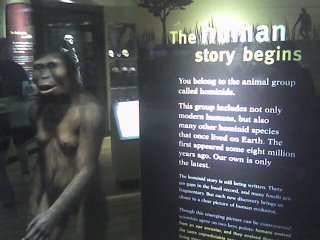 It's the beginning of us too. The human, or hominid, story. A sign reads:
It's the beginning of us too. The human, or hominid, story. A sign reads:
 This is Lucy, one of the museum's famous artifacts. It is one of the earliest hominids. He or she was found in eastern Africa and is dated at 3.2 million years ago. Lucy belong to the Australopithecines that lived around four million to one million years ago.
This is Lucy, one of the museum's famous artifacts. It is one of the earliest hominids. He or she was found in eastern Africa and is dated at 3.2 million years ago. Lucy belong to the Australopithecines that lived around four million to one million years ago.
She is said to be a good girl, crazy about Elvis, loves horses, and her boyfriend too.
OK, I made that last part up.
Guys and girls like Lucy have been a focal point of the Creationism versus Evolution debate in the last Century.
 This is a cast of "Turkana Boy," who lived and died near Lake Turkana in Kenya, Africa 1.6 million years ago. Wikipedia notes:
This is a cast of "Turkana Boy," who lived and died near Lake Turkana in Kenya, Africa 1.6 million years ago. Wikipedia notes:
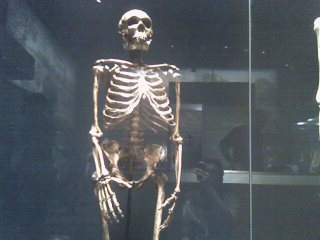 Here is another cast of the "Neanderthal human," dated 1.8 million to 10,000 years ago. Heavier bones, broader shoulders, wider ribs, short limbs, and stocky bodies may have helped them retain heat in colder climates.
Here is another cast of the "Neanderthal human," dated 1.8 million to 10,000 years ago. Heavier bones, broader shoulders, wider ribs, short limbs, and stocky bodies may have helped them retain heat in colder climates.
 This is a cast of a modern human dated 10,000 years ago to the present. We have a flatter face and a taller forehead. We have a protruding, rather than a flat nose. We have a pointy, rather than receding chins.
This is a cast of a modern human dated 10,000 years ago to the present. We have a flatter face and a taller forehead. We have a protruding, rather than a flat nose. We have a pointy, rather than receding chins.
We have Nicole Kidman. Cavemen do not. That is why we live and they do not.
 Here are the two side by side. I'll take Nicole Kidman on the right any day.
Here are the two side by side. I'll take Nicole Kidman on the right any day.
 At this point, the Earth was going through its Quaternary Period (1.8 million years ago to today), which is an ice age. Yes, we live in an ice age right now that peaked 18,000 years ago. This is why Canadians still watch hockey.
At this point, the Earth was going through its Quaternary Period (1.8 million years ago to today), which is an ice age. Yes, we live in an ice age right now that peaked 18,000 years ago. This is why Canadians still watch hockey.
It is divided into smaller chunks of time. One significant one is the Pleistocene epoch, which is dated at 1.8 million to 10,000 years ago. According to this Berkeley Website that I have relied on greatly, much of the world's temperate zones were alternately covered by glaciers during cool periods and uncovered during the warmer interglacial periods when the glaciers retreated.
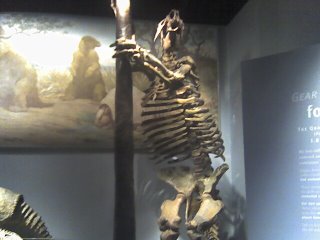 Our early time period brought with it some pretty interesting animals, like this giant ground sloth, dated 1.8 million to 10,000 years ago.
Our early time period brought with it some pretty interesting animals, like this giant ground sloth, dated 1.8 million to 10,000 years ago.
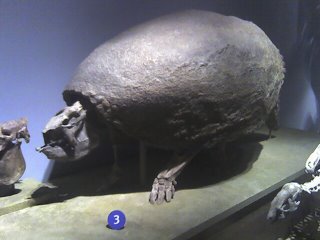 Here's the Glyptodont, which lived 1.8 million to 10,000 years ago.
Here's the Glyptodont, which lived 1.8 million to 10,000 years ago.
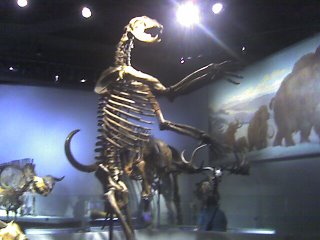 Here is the "short faced" bear, Arctodus Simus. It's dated at 1.8 million to 10,000 years ago and is found in Indiana. It had a good lay-up.
Here is the "short faced" bear, Arctodus Simus. It's dated at 1.8 million to 10,000 years ago and is found in Indiana. It had a good lay-up.
 Irish deer, some of the largest ones of all time, lived across Europe, Asia and even Northern Africa before they started dying out around 8,000 years ago. I blame the British for all of the troubles in Ireland.
Irish deer, some of the largest ones of all time, lived across Europe, Asia and even Northern Africa before they started dying out around 8,000 years ago. I blame the British for all of the troubles in Ireland.

Here's the Woolly mammoth, dated 1.8 million-10,000 years ago. Much is known about them due to frozen carcasses found in Siberia.
 The Mastodons were the mammoths' leaf-eating cousins and went extinct about 10,000 years ago.
The Mastodons were the mammoths' leaf-eating cousins and went extinct about 10,000 years ago.
 This all leads us to today...
This all leads us to today...
 ...otherwise known as Mass Extinction #6. Scientists estimate that we have lost 30,000 species in the last year. It's possible that many more that we do not even know exist are also dying.
...otherwise known as Mass Extinction #6. Scientists estimate that we have lost 30,000 species in the last year. It's possible that many more that we do not even know exist are also dying.
 Why? Us. Humans. We suck. A sign reads: "For the first time in Earth's history, a single species is the primary cause of a mass extinction." This is a somewhat hyperbolic statement, since we do not know what caused extinctions in the past, but it is not to say that we as a species are not wiping away life on the planet as we know it.
Why? Us. Humans. We suck. A sign reads: "For the first time in Earth's history, a single species is the primary cause of a mass extinction." This is a somewhat hyperbolic statement, since we do not know what caused extinctions in the past, but it is not to say that we as a species are not wiping away life on the planet as we know it.
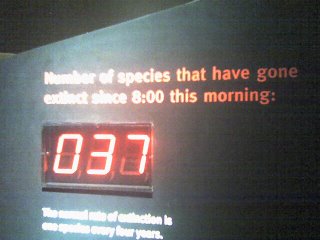 Near the museum's closing time of 5PM, 37 species have been wiped away since 8AM that morning. They were probably all run over by SUV's and personally assassinated by Dick Cheney during a hunting trip. I really don't want to make too much light of the matter, as the museum points out that the normal rate of extinction is one species every four years. Right now species are dying out at a rate of 30,000 per year. 82 species every day. Four species every hour.
Near the museum's closing time of 5PM, 37 species have been wiped away since 8AM that morning. They were probably all run over by SUV's and personally assassinated by Dick Cheney during a hunting trip. I really don't want to make too much light of the matter, as the museum points out that the normal rate of extinction is one species every four years. Right now species are dying out at a rate of 30,000 per year. 82 species every day. Four species every hour.
At least according to our very incomplete estimates. It is here that we stray away from saying what we know and speculating about things we have very little data on. We really don't have a clue how many species existed in the past, and at what rate they died. We are lucky to find them at all in fossils, which is a rare phenomenon that happens in very specific circumstances. When I see a statement like this, I recoil slightly, as it makes me question the entire presentation. It is a supposition. The numbers of species dying are shocking enough, the speculative comparisons seems out of place.
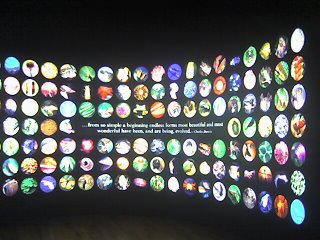 Nevertheless, the "Evolving Planet" exhibit is a powerful exhibit. It shows many life forms over time. It shows their similarities. It is not a "smoking gun," however. It does show sufficient proof that life forms over time are connected in real ways. It does not prove that these connections were random acts, and that no Intelligent Designer was involved. It of course does not provide any proof that an Intelligent Designer exists either. Intelligent people, we hope, may come up with their own conclusions.
Nevertheless, the "Evolving Planet" exhibit is a powerful exhibit. It shows many life forms over time. It shows their similarities. It is not a "smoking gun," however. It does show sufficient proof that life forms over time are connected in real ways. It does not prove that these connections were random acts, and that no Intelligent Designer was involved. It of course does not provide any proof that an Intelligent Designer exists either. Intelligent people, we hope, may come up with their own conclusions.
Perhaps scientific museums will more properly separate facts from supposition, so that broad generalizations of facts will not be presented more like theology than fact-finding science.
 Here's a quote from Charles Darwin that says "...from so simple a beginning endless forms most beautiful and most wonderful have been, and are being, evolved."
Here's a quote from Charles Darwin that says "...from so simple a beginning endless forms most beautiful and most wonderful have been, and are being, evolved."
Maybe not.
Well, so much for separation of church and state...at least when it comes to the theology of naturalism. Nevertheless, this is the perspective of most scientists and certainly the Field Museum. It is a fantastic, compelling, and convincing argument. I do not believe that Creationists or proponents of Intelligent Design have anything close to it in terms of scope and evidence.
I defy them to present one if they have it.
I strongly suggest everyone near Chicago go to the Field Museum and check this out. If you have strong religious beliefs, or you are very much an atheist, does not matter. This was one of the most interesting exhibits I have ever seen, and it is well worth your time to expose yourself to it.
It is, after all, the history of us.
RELATED LINKS:
A critical view of the Evolving Planet exhibit from Answers in Genesis.
The Creationist argument against Carbon Dating.
Dinosaurs and the Bible.
At this point in the exhibit, 50% of life on Earth has been wiped away, including all the dinosaurs that were not birds.
 With them out of the way, 65 million years ago, it was the end of the Cretaceous period and the start of the age of the mammals. Us. The good guys (we think). Our world as we know it began to take shape. The Tertiary period (65-1.8 million years ago) was in full swing.
With them out of the way, 65 million years ago, it was the end of the Cretaceous period and the start of the age of the mammals. Us. The good guys (we think). Our world as we know it began to take shape. The Tertiary period (65-1.8 million years ago) was in full swing. Plant and animal life (specifically mammals) that is familiar to us started to flourish.
Plant and animal life (specifically mammals) that is familiar to us started to flourish. Fossils of some familiarity began to be found.
Fossils of some familiarity began to be found.This Sycamore leaf is dated 54.8-33.7 million years ago and was found in Wyoming.
 This fantastic fossil is a pregnant stingray with its embryo and herrings, dated 54.8-33.7 million years ago. This was also found in Wyoming.
This fantastic fossil is a pregnant stingray with its embryo and herrings, dated 54.8-33.7 million years ago. This was also found in Wyoming. This soft-shelled turtle with fishes and love bugs inside is also dated 54.8-33.7 million years ago and found in Wyoming. It is a wonderful fossil because it not only shows the larger animal, but smaller ones as well.
This soft-shelled turtle with fishes and love bugs inside is also dated 54.8-33.7 million years ago and found in Wyoming. It is a wonderful fossil because it not only shows the larger animal, but smaller ones as well. This Herring-like fish (Diplomystus dentatus) is dated 54-8-33.7 million years ago and found in Wyoming (it's possible there are more fossils found there than people).
This Herring-like fish (Diplomystus dentatus) is dated 54-8-33.7 million years ago and found in Wyoming (it's possible there are more fossils found there than people).Around 45 million years ago, moving continents (again!) caused the Earth's climate to begin shifting from warm and wet to cooler and drier (damn that global cooling!). This of course affected evolution of plant and animal life.
 Grasslands spread, which benefited hoofed mammals.
Grasslands spread, which benefited hoofed mammals.Three million years ago, a land bridge formed between North and South America, connecting species for the first time in millions of years. This would particularly affect mammal life.
 It's the beginning of us too. The human, or hominid, story. A sign reads:
It's the beginning of us too. The human, or hominid, story. A sign reads:The hominid story is still being written. There are gaps in the fossil record, and many fossils are fragmentary. But each new discovery brings us closer to a clear picture of human evolution.This is random natural selection, I presume. No God here. Even if we can't prove it. How this is science and not theology when it is based on an "agreement" I am not sure. It seems to me to be a very blurry line.
Though this emerging picture can be controversial scientists agree on two key points: humans evolved from an ape ancestor, and they evolved through the same unpredictable process as every other living thing.
 This is Lucy, one of the museum's famous artifacts. It is one of the earliest hominids. He or she was found in eastern Africa and is dated at 3.2 million years ago. Lucy belong to the Australopithecines that lived around four million to one million years ago.
This is Lucy, one of the museum's famous artifacts. It is one of the earliest hominids. He or she was found in eastern Africa and is dated at 3.2 million years ago. Lucy belong to the Australopithecines that lived around four million to one million years ago.She is said to be a good girl, crazy about Elvis, loves horses, and her boyfriend too.
OK, I made that last part up.
Guys and girls like Lucy have been a focal point of the Creationism versus Evolution debate in the last Century.
 This is a cast of "Turkana Boy," who lived and died near Lake Turkana in Kenya, Africa 1.6 million years ago. Wikipedia notes:
This is a cast of "Turkana Boy," who lived and died near Lake Turkana in Kenya, Africa 1.6 million years ago. Wikipedia notes:There are several features which seem awkward in comparison to modern humans. The pelvic structure is narrower than in modern Homo sapiens, meaning that Homo ergaster and Homo erectus in both Africa and Asia had a greater ability to run. Their running techniques may have been equivalent to a modern day race track athlete. This hints that the species lived a harsh and demanding lifestyle; most importantly they must have been accomplished hunters rather than scavengers such as Homo habilis. Radical changes are believed to have taken place during the transformation between the australopithecines and Homo species. Because of Homo ergaster's greater height and limb proportions which are more similar to Homo sapiens than to the ape-like australopithecines, a combination of height and likely absence of fur would have been a necessity.He is described in the museum as an "early human," dated 1.8 million to 10,000 years ago. A nearby sign says:
"Our own species, Homo sapiens," first evolved around 195,000 years ago in Africa.The Neanderthals were last seen in Geico commercials.
Today, we are the only hominid species. But that has not always been true. Until quite recently, we shared the earth with at least two other hominid species.
The last of these species only died out around 30,000 years ago: Homo neanderthalensis, better known as the Neanderthals."
 Here is another cast of the "Neanderthal human," dated 1.8 million to 10,000 years ago. Heavier bones, broader shoulders, wider ribs, short limbs, and stocky bodies may have helped them retain heat in colder climates.
Here is another cast of the "Neanderthal human," dated 1.8 million to 10,000 years ago. Heavier bones, broader shoulders, wider ribs, short limbs, and stocky bodies may have helped them retain heat in colder climates. This is a cast of a modern human dated 10,000 years ago to the present. We have a flatter face and a taller forehead. We have a protruding, rather than a flat nose. We have a pointy, rather than receding chins.
This is a cast of a modern human dated 10,000 years ago to the present. We have a flatter face and a taller forehead. We have a protruding, rather than a flat nose. We have a pointy, rather than receding chins.We have Nicole Kidman. Cavemen do not. That is why we live and they do not.
 Here are the two side by side. I'll take Nicole Kidman on the right any day.
Here are the two side by side. I'll take Nicole Kidman on the right any day. At this point, the Earth was going through its Quaternary Period (1.8 million years ago to today), which is an ice age. Yes, we live in an ice age right now that peaked 18,000 years ago. This is why Canadians still watch hockey.
At this point, the Earth was going through its Quaternary Period (1.8 million years ago to today), which is an ice age. Yes, we live in an ice age right now that peaked 18,000 years ago. This is why Canadians still watch hockey.It is divided into smaller chunks of time. One significant one is the Pleistocene epoch, which is dated at 1.8 million to 10,000 years ago. According to this Berkeley Website that I have relied on greatly, much of the world's temperate zones were alternately covered by glaciers during cool periods and uncovered during the warmer interglacial periods when the glaciers retreated.
 Our early time period brought with it some pretty interesting animals, like this giant ground sloth, dated 1.8 million to 10,000 years ago.
Our early time period brought with it some pretty interesting animals, like this giant ground sloth, dated 1.8 million to 10,000 years ago. Here's the Glyptodont, which lived 1.8 million to 10,000 years ago.
Here's the Glyptodont, which lived 1.8 million to 10,000 years ago. Here is the "short faced" bear, Arctodus Simus. It's dated at 1.8 million to 10,000 years ago and is found in Indiana. It had a good lay-up.
Here is the "short faced" bear, Arctodus Simus. It's dated at 1.8 million to 10,000 years ago and is found in Indiana. It had a good lay-up. Irish deer, some of the largest ones of all time, lived across Europe, Asia and even Northern Africa before they started dying out around 8,000 years ago. I blame the British for all of the troubles in Ireland.
Irish deer, some of the largest ones of all time, lived across Europe, Asia and even Northern Africa before they started dying out around 8,000 years ago. I blame the British for all of the troubles in Ireland.
Here's the Woolly mammoth, dated 1.8 million-10,000 years ago. Much is known about them due to frozen carcasses found in Siberia.
 The Mastodons were the mammoths' leaf-eating cousins and went extinct about 10,000 years ago.
The Mastodons were the mammoths' leaf-eating cousins and went extinct about 10,000 years ago. This all leads us to today...
This all leads us to today... ...otherwise known as Mass Extinction #6. Scientists estimate that we have lost 30,000 species in the last year. It's possible that many more that we do not even know exist are also dying.
...otherwise known as Mass Extinction #6. Scientists estimate that we have lost 30,000 species in the last year. It's possible that many more that we do not even know exist are also dying. Why? Us. Humans. We suck. A sign reads: "For the first time in Earth's history, a single species is the primary cause of a mass extinction." This is a somewhat hyperbolic statement, since we do not know what caused extinctions in the past, but it is not to say that we as a species are not wiping away life on the planet as we know it.
Why? Us. Humans. We suck. A sign reads: "For the first time in Earth's history, a single species is the primary cause of a mass extinction." This is a somewhat hyperbolic statement, since we do not know what caused extinctions in the past, but it is not to say that we as a species are not wiping away life on the planet as we know it. Near the museum's closing time of 5PM, 37 species have been wiped away since 8AM that morning. They were probably all run over by SUV's and personally assassinated by Dick Cheney during a hunting trip. I really don't want to make too much light of the matter, as the museum points out that the normal rate of extinction is one species every four years. Right now species are dying out at a rate of 30,000 per year. 82 species every day. Four species every hour.
Near the museum's closing time of 5PM, 37 species have been wiped away since 8AM that morning. They were probably all run over by SUV's and personally assassinated by Dick Cheney during a hunting trip. I really don't want to make too much light of the matter, as the museum points out that the normal rate of extinction is one species every four years. Right now species are dying out at a rate of 30,000 per year. 82 species every day. Four species every hour.At least according to our very incomplete estimates. It is here that we stray away from saying what we know and speculating about things we have very little data on. We really don't have a clue how many species existed in the past, and at what rate they died. We are lucky to find them at all in fossils, which is a rare phenomenon that happens in very specific circumstances. When I see a statement like this, I recoil slightly, as it makes me question the entire presentation. It is a supposition. The numbers of species dying are shocking enough, the speculative comparisons seems out of place.
 Nevertheless, the "Evolving Planet" exhibit is a powerful exhibit. It shows many life forms over time. It shows their similarities. It is not a "smoking gun," however. It does show sufficient proof that life forms over time are connected in real ways. It does not prove that these connections were random acts, and that no Intelligent Designer was involved. It of course does not provide any proof that an Intelligent Designer exists either. Intelligent people, we hope, may come up with their own conclusions.
Nevertheless, the "Evolving Planet" exhibit is a powerful exhibit. It shows many life forms over time. It shows their similarities. It is not a "smoking gun," however. It does show sufficient proof that life forms over time are connected in real ways. It does not prove that these connections were random acts, and that no Intelligent Designer was involved. It of course does not provide any proof that an Intelligent Designer exists either. Intelligent people, we hope, may come up with their own conclusions.Perhaps scientific museums will more properly separate facts from supposition, so that broad generalizations of facts will not be presented more like theology than fact-finding science.
 Here's a quote from Charles Darwin that says "...from so simple a beginning endless forms most beautiful and most wonderful have been, and are being, evolved."
Here's a quote from Charles Darwin that says "...from so simple a beginning endless forms most beautiful and most wonderful have been, and are being, evolved."Maybe not.
Well, so much for separation of church and state...at least when it comes to the theology of naturalism. Nevertheless, this is the perspective of most scientists and certainly the Field Museum. It is a fantastic, compelling, and convincing argument. I do not believe that Creationists or proponents of Intelligent Design have anything close to it in terms of scope and evidence.
I defy them to present one if they have it.
I strongly suggest everyone near Chicago go to the Field Museum and check this out. If you have strong religious beliefs, or you are very much an atheist, does not matter. This was one of the most interesting exhibits I have ever seen, and it is well worth your time to expose yourself to it.
It is, after all, the history of us.
RELATED LINKS:
A critical view of the Evolving Planet exhibit from Answers in Genesis.
The Creationist argument against Carbon Dating.
Dinosaurs and the Bible.



0 Comments:
Post a Comment
|<< Home